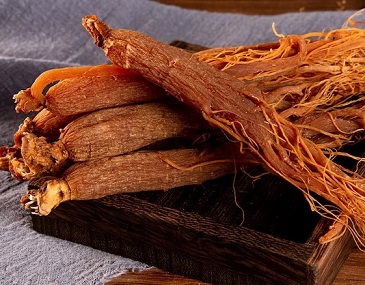Herbs And Phytochemicals: Murine Study Shows That Red Ginseng Extract Inhibits Lipopolysaccharide-Induced Platelet-Leukocyte Aggregates
Nikhil Prasad Fact checked by:Thailand Medical News Team Apr 23, 2024 1 year, 8 months, 1 week, 1 day, 21 hours, 41 minutes ago
Herbs And Phytochemicals: In the realm of herbal medicine and phytochemical research, the potential therapeutic properties of various natural compounds continue to intrigue scientists and healthcare professionals alike. Among these, red ginseng extract (RGE), derived from the Panax ginseng plant, has garnered significant attention for its purported anti-inflammatory, antiplatelet, and antithrombotic activities. However, a nuanced understanding of how RGE impacts complex physiological processes, such as platelet-leukocyte aggregate (PLA) formation in the context of sepsis, remains a subject of ongoing investigation.
 Murine Study Shows That Red Ginseng Extract Inhibits
Murine Study Shows That Red Ginseng Extract Inhibits
Lipopolysaccharide-Induced Platelet-Leukocyte Aggregates
A
Herbs And Phytochemicals study by researchers from Kyungpook National University-Republic of Korea, University of Maryland-USA and Pir Mehr Ali Shah Arid Agriculture University, Rawalpindi-Pakistan involving mice models found that red ginseng extract inhibits lipopolysaccharide-induced platelet-leukocyte aggregates.
Unraveling the Complexity of Platelet-Leukocyte Aggregates (PLAs)
The intricate interplay between platelets and leukocytes, culminating in the formation of PLAs, holds pivotal implications for cardiovascular health, inflammatory responses, and thrombo-inflammatory disorders like sepsis. PLAs, characterized by the adhesion and aggregation of platelets with leukocytes, are not merely passive bystanders but active contributors to pathophysiological cascades. These aggregates, facilitated by molecular interactions such as CD62P (P-selectin) on platelets and P-selectin glycoprotein ligand-1 on leukocytes, serve as conduits for inflammation, coagulation, and immune dysregulation.
Bridging the Gap: Murine Study on RGE's Impact
To delve deeper into the potential therapeutic role of RGE in mitigating PLA formation, a detailed study was undertaken by the study team. The study utilized a murine model induced with lipopolysaccharide (LPS), a microbial toxin mimicking sepsis, to simulate the complex interplay of inflammatory and thrombotic processes.
Methodology and Experimental Design
Six-week-old ICR mice were subjected to oral gavage of varying doses of RGE for seven consecutive days. Subsequently, an intraperitoneal injection of LPS was administered to induce a septic state. After 24 hours, blood samples were collected for comprehensive analysis using advanced techniques such as flow cytometry, confocal microscopy, scanning electron microscopy, and enzyme-linked immunosorbent assay (ELISA). These methodologies allowed for the precise quantification and visualization of platelet activation, PLA formation, and associated molecular markers.
Insights from Experimental Findings
The study's findings revealed several key insights into RGE's inhibitory effects on PLA formation and its underlying mechanisms:
1. Reduction in Platelet Activation: Treatment with RGE, particularly at doses of 200 and 400 mg/kg, demonstrated a significant decrease in the population of activated platelets (CD41+CD62P+). This reduction in platelet activation suggests a potential antiplatelet effect of RGE, mitigating the initial steps of PLA formation.
2. Attenuation of Platelet-Leukocyte Aggregates (PLAs) and Platelet-Neutrophil Aggregates (PNAs): In septic mice, there was a notable increase in PLAs and PNAs, indicative of heightened thrombo-inflammatory responses. However, RGE administration led to a marked reduction in both PLAs (CD41+CD11b+) and PNAs (CD41+Ly6G+), signifying its ability to interfere with platelet-leukocyte interactions crucial for aggregate formation.
3. Visual Confirmation through Microscopy: Confocal microscopy and scanning electron microscopy provided visual confirmation of the inhibitory effects of RGE on PLA and PNA formation. Morphological changes in platelets and leukocytes, along with the absence of characteristic aggregate structures in RGE-treated groups, further supported the study's findings.
4. Modulation of Molecular Markers: Enzyme-linked immunosorbent assay (ELISA) analysis revealed a reduction in tissue factor (TF) and platelet factor 4 (PF4) levels in the plasma of mice treated with higher doses of RGE (400 mg/kg). These molecular changes align with the observed decrease in PLA and PNA formation, highlighting potential mechanistic pathways through which RGE exerts its inhibitory effects.
Implications for Clinical Practice and Future Research
The implications of these findings extend beyond the realm of experimental murine models, offering valuable insights into potential therapeutic strategies for thrombo-inflammatory disorders in clinical settings. Given the multifaceted nature of PLA formation and its implications for conditions such as sepsis, cardiovascular diseases, and inflammatory disorders, the therapeutic potential of RGE warrants further exploration.
Potential Mechanisms and Future Directions
While this study sheds light on RGE's inhibitory effects on PLA formation, several avenues for future research and mechanistic elucidation emerge:
1. Receptor-Specific Interactions: Understanding the specific receptors or molecular targets through which RGE modulates platelet activation and leukocyte interactions can provide deeper mechanistic insights.
2. Signaling Pathways: Exploring the intracellular signaling pathways, such as NFκB and MAPK pathways, involved in RGE-mediated inhibition of PLA formation could unravel novel therapeutic targets.
3. Clinical Translatability: Translating these preclinical findings into clinical trials and evaluating the safety and efficacy of RGE or its bioactive constituents in human subjects with thrombo-inflammatory conditions is a crucial next step.
Conclusion: Harnessing Nature's Potential
In conclusion, the collaborative murine study on RGE's inhibitory effects on LPS-induced PLA formation underscores the therapeutic potential of natural compounds in modulating complex physiological processes. From herbal extracts to phytochemical constituents, nature offers a rich repertoire of bioactive agents that merit exploration in the realm of cardiovascular health, inflammation, and thrombo-inflammatory disorders. By unraveling the intricate mechanisms underlying PLA formation and targeting them with precision, researchers pave the way for innovative therapeutic interventions rooted in the bounties of herbal medicine and phytochemistry.
The study findings were published in the peer reviewed Journal of Ginseng Research.
https://www.sciencedirect.com/science/article/pii/S1226845324000447
For the latest on
Herbs And Phytochemicals, keep on logging to Thailand Medical News.
